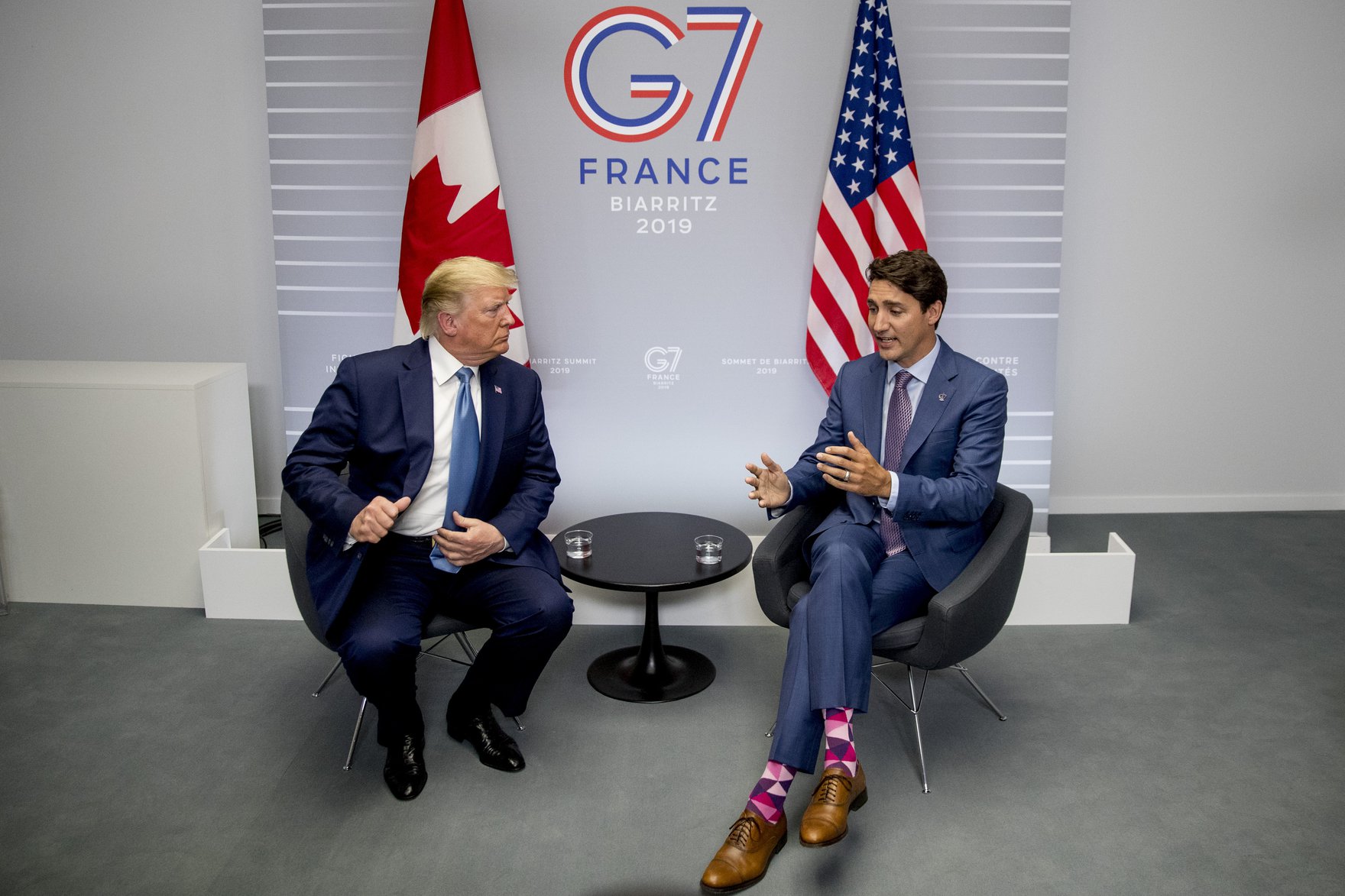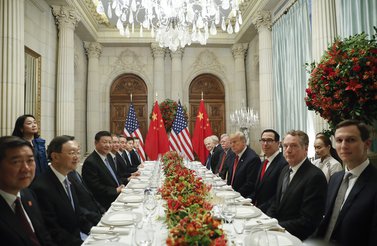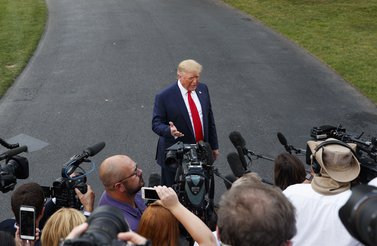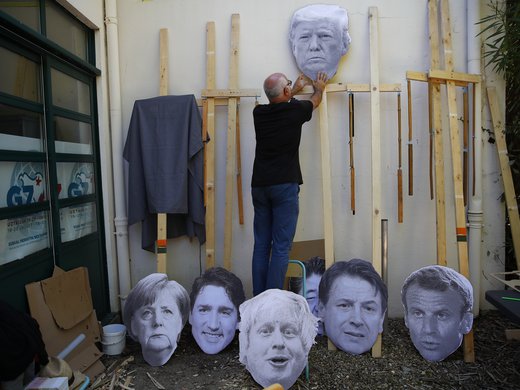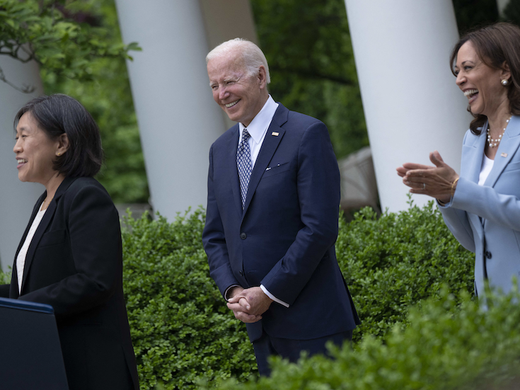As the Group of Seven (G7) leaders conclude talks in Biarritz, storm clouds over international commercial relations are darkening. While the G7 is best placed to address specific frictions between the European Union and the United States — specifically the US threat to impose tariffs on auto imports from the EU and plans by several EU member states (including G7 host, France) to impose a tax on digital services companies that are largely based in that the United States — the larger issue is the deteriorating trade relationship between the United States and China. At the moment, the prospects for a negotiated settlement to an escalating bilateral trade war appear to be dim, while the risk to the global economy is growing. With markets unsettled by the latest rounds of escalation, and showing increasing scepticism with every renewal of trade talks, how should Canadian economic and trade policy respond?
The Deep Roots of this Trade War
From the very start of the Trump presidency, the administration made it a priority to reorder US trade relations with the world. Trump pulled the United States out of the Comprehensive and Progressive Agreement for Trans-Pacific Partnership (CPTPP, formerly the TPP) as his first major initiative in office, renegotiated NAFTA through the new Canada-United States-Mexico Agreement (CUSMA), pressured the European Union to cut a deal on US terms, ramped up pressure for reforms to the World Trade Organization (WTO) by refusing to agree to the appointment of Appellate Body members (effectively hamstringing the organization), and dusted off decades-old unilateral trade measures to impose tariffs for US industrial policy purposes, including on Canadian steel and aluminum exports.
But the big fish was China. Citing a litany of “China cheats” complaints, Trump announced a set of demands on China in 2018, about which the Financial Times wrote that “if one sat down and made a determined effort, it would be hard to come up with a more economically wrong-headed, diplomatically toxic and legally destructive negotiating position than that presented to China last week by a visiting US trade delegation.”
Against that unpromising background, Trump imposed several rounds of tariff increases on imports from China, had the US Department of Justice launch a “China initiative” to scrutinize the activities of Chinese nationals (including using extradition treaties to extend the reach of US laws), banned sales of critical technology to designated Chinese “entities” (which included China’s flagship technology company, Huawei), and rolled back Chinese investment in the US economy. Many of the measures were imposed on grounds of national security, which militates against an eventual deal since national security is non-negotiable. At the same time, muddying the waters, Trump has intimated that these measures are intended to provide leverage to extract trade concessions from China in areas such as market access for US services suppliers, increased protection of intellectual property rights, restrictions on subsidies to state-owned enterprises and the granting of effective diktat for the United States in enforcement of the terms of a future agreement. Importantly from this latter perspective, Trump provided relief from the technology export bans to Chinese firms that could have been effectively crippled by these measures.
For its part, China, following its established policy, has retaliated in tit-for-tat fashion to each US tariff salvo and walked away from what it characterized as “unequal treaties.”
Meanwhile, even as tariffs and counter-tariffs were raised, US-China bilateral talks continued. The result of these negotiations was a 150-page secret document that didn’t fly; talks broke down in May 2019. Why they broke down depends on whose story you believe. This is hardly surprising: to paraphrase Otto von Bismarck, never are more lies told than before an election, during a negotiation, or after the hunt.
Talks reopened in Shanghai at the end of July 2019 under a cloud of downplayed expectations. China made a goodwill gesture by announcing that it would resume the purchase of US agricultural products — the associated tariffs were revealing themselves to be China’s greatest source of leverage in the bilateral talks. This was true to form: China would love to settle the hostilities by writing a cheque.
However, things quickly fell apart again. Trump reciprocated China’s gesture by announcing the imposition of tariffs on $300 billion additional imports from China, effective September 1, 2019. That too was true to form: escalation is the first chapter in the Trump playbook. China, in turn, retaliated by withdrawing its offer to purchase US agricultural products; this took place despite understanding that retaliation would likely result in further US escalation.
Signs that the trade war was resulting in casualties quickly surfaced. President Trump printed money to placate US farmers — also true to form — and delayed the imposition of some of the September tariffs until December to ease the impact on US households. Meanwhile, China’s currency came under renewed pressure. The Chinese authorities declined to defend the currency and allowed it to break through the level of seven renminbi to the US dollar, which was widely understood to have symbolic significance as it provided markets with an anchor for expectations. China hauled up that anchor and the United States pronounced China a “currency manipulator.” This set the currency manipulation analytical community into overdrive, leading to the almost unanimous conclusion that China was not manipulating its currency.
On 23 August 2019, China announced its latest retaliatory measures on some $75 billion of Chinese imports from the United States, which would be timed to coincide with the September 1 and December 15 US tariff hikes. Trump immediately announced that the punitive tariffs on China would be increased by 5 percent as of October 1, 2019, and tweeted that American companies “are hereby ordered to immediately start looking for an alternative to China, including bringing your companies HOME and making your products in the USA.”
Equity markets, which had surged on the earlier comments of Federal Reserve Board Chairman Jerome Powell at the annual Jackson Hole central bank conference, that the Federal Reserve would take measures to support the economy, promptly plunged, even as G7 leaders gathered at Biarritz.
What Happens Next?
The latest round of escalations points to an acceleration in the breakdown of China-US bilateral commercial relations (China-US “decoupling” or “Chexit”). There is no obvious exit from Chexit.
For its part, the United States has to date absorbed — with relatively minimal flinching — the moderate pain from higher consumer prices that its own tariffs impose, the sharper but much more localized pain from loss of agricultural exports due to China’s retaliation, and the complaints from the US tech community facing a loss of revenue from sales to Huawei and other Chinese tech firms. Some tariffs have been delayed, some product exemptions from export restrictions have been granted, and the window in which US technology can be sold to named entities has been extended. Nonetheless, the main thrust of the tariffs and technology restrictions remains in force.
The outcome of the tariff and technology war is simply not clear at this point. In the short term, the United States is in the relatively stronger position: its economy remains relatively robust while China’s has slowed.
Meanwhile in China, President Xi has already invoked the Long March to characterize China’s long-game strategy to weather the US assault. Beyond the high symbolism that this reference invokes for a Chinese audience, China has already long since mobilized to replace the denied US technology, particularly in its most vulnerable area of computer chip design and production. The government has offered tax holidays to its private sector, tech giant Alibaba has entered the field by acquiring a Chinese chip manufacturer and putting its financial weight behind research and development, and Huawei, which has come to symbolize China’s emergence as a digital economy tech power, has triple-shifted research and development staff to develop alternatives to US technology products while it survives on stockpiled reserves to maintain production of consumer products and 5G network systems in the face of US sanctions.
The outcome of the tariff and technology war is simply not clear at this point. In the short term, the United States is in the relatively stronger position: its economy remains relatively robust while China’s has slowed sharply – possibly approaching stall speed (year-over-year growth in China’s use of electricity fell to 2.7 percent in July for the economy as a whole and to 1.2 percent for manufacturing, according to data from the China Electricity Council). The US debt risk is minimal: it is concentrated in the public sector and is denominated in US dollars, which the Federal Reserve Board can print at will. Given the US dollar’s pivotal role as the main currency for international exchange, private sector hedging, state reserve holdings, and safe-haven status, there is no real risk to US finances. China’s debt risk is much larger – it is concentrated in the private sector and its state-owned banks. However, China retains $3.1 trillion worth of foreign exchange reserves, which it could use to recapitalize its banking system to prevent a meltdown.
On the technology front, the near-term prospects for China are problematic given that the United States controls critical technologies. If China can get to the long run, we will see a seismic transformation of the technology landscape. In today’s environment of accelerated innovation, it is not unreasonable to suppose that the estimated two-to-five-year lag in chip design could evaporate rather quickly. However, it is not clear whether that is a bridge too far. From Huawei and other Chinese firms, we can anticipate bravado, red ink, recrimination, missed launch targets and extraordinary support from the Chinese government. From US commentators, we can expect both dismissive assessment of China’s capabilities and warnings from US technology suppliers about the risks of losing sales to China while incentivizing China’s development of capabilities in US areas of technological comparative advantage. It is in none of the players’ interests to provide an honest read-out of the situation.
The outlook for markets is even more problematic. Markets had been urged to believe there would be a deal at the end of this trade war ordeal. The latest rounds of major escalations have greatly undermined any such belief, especially as a looming currency war is now overlaid on an already over-the-top trade war and an apparently irreconcilable technology war. Almost immediately upon announcement of the breakdown in talks in Shanghai, the central banks of New Zealand, India and Thailand lowered their policy rates, signalling lower currency values and macroeconomic weakening. Mexico has since followed. Coming out of the G7 meetings in Biarritz and the central bank convocation at Jackson Hole, the signals are likely to be of preparedness to support global economic activity in the context of a failure to ratchet down the trade tensions. Meanwhile, the usual canaries in the global economy coal mine — Argentina and Turkey — are singing.
How Will US-China Tension Impact Canada?
Canada must prepare for a rough patch in global economic relations. It approaches this episode in almost as good a shape as could be hoped for.
In macroeconomic terms, the economy is growing, the unemployment rate is hovering at its lowest point in decades, inflation is moderate and at the centre of the Bank of Canada’s target band, and Canada’s net general government debt as a share of its GDP is the lowest among its peers. The only vulnerability is the current account deficit of about three percent of GDP.
In trade terms, Canada has recently concluded agreements with the United States and Mexico (CUSMA, revising NAFTA), with the European Union (the Comprehensive Economic and Trade Agreement), and with the Pacific Rim economies (CPTPP and the Canada-Korea Free Trade Agreement).
Nothing can be taken for granted, however. New risks to Canada’s global market access are popping up with unnerving frequency. The European Union is contemplating measures that would restrict some of Canada’s agricultural exports on plant health grounds. Japan has apparently concluded a deal of questionable legality under WTO rules with the United States to protect itself from US tariffs on its auto exports; the result would undermine Canadian market access in key sectors like beef, which it obtained under the CPTPP. With Trump in the White House, access to the US market will be uncertain. Canada’s market access in China is withering due to the Meng Wanzhou arrest.
Without gainsaying the need to double down on efforts to preserve international market access at a time of flaring protectionism, Canada also has to double down on its own areas of domestic strength. In particular, even as the largest and most powerful economies in the world go head-to-head to see who will dominate the future economy based on big data, machine learning and artificial intelligence — the major battleground in this trade war — Canadian policymakers should be keenly aware that this contest will induce massive investment in areas where Canada has a strong suit. Canada has outstanding skills and a robust performance in start-ups in this emerging data-driven economy. And it has the fiscal wherewithal to ensure that Canadian tech is not shouldered aside as other countries throw — literally — hundreds of billions of development dollars to gain ascendancy. Canada’s weakness is in scaling up companies; this is the time to be bold and throw some serious money at this problem. There is nothing more sensible than focusing on developing Canada’s own technological capacities during a patch of global turbulence. There will be no regrets about this.
Finally, Canada needs a realistic lens on the rapidly evolving international context. The United States is not a constant, nor is China, and the European Union is on the brink of a profound transformation. The geopolitics of the postwar era and the institutions to which it gave rise is similarly on the cusp of profound change. Under Prime Minister Pierre Elliot Trudeau, Canada sought a “third option.” Today, Canada is seeking a fourth.
